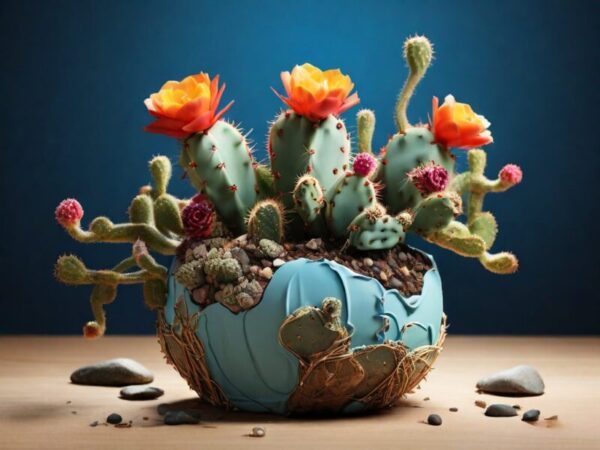- Introduction
- The best times for grafting
- Selecting the right rootstocks and scions
- Step-by-step instructions for grafting
- Care after grafting
- Common problems and their solution
Here you can find our selection of cactus seeds!
1. introduction
Grafting cacti is a fascinating technique that combines two different plants to create a single, uniform plant. The vascular systems of both parts of the plant grow together and form a new, more robust plant. This method is especially used for cacti that are difficult to root or propagate and allows for efficient propagation of your favorite plants. From Mammillaria to prickly pear, grafting opens up exciting opportunities to expand your collection on the windowsill or in the garden, bringing slower growing succulents to flower and seed production more quickly.
Below we will look at the best times to graft, choosing the right rootstocks and scions and provide a step-by-step guide to successfully grafting your cacti. From post-graft care to solutions for common problems, all important aspects are covered. This knowledge is indispensable for successfully propagating your succulents and cacti, such as the Christmas cactus or the fat hen.
2. the best times for grafting
Successful grafting of cacti depends heavily on choosing the right time. The optimum time for grafting is when both the rootstock and the scion are actively growing and full of sap. This is usually the case between May and August. Here are some specific guidelines to help you determine the ideal time for your grafting projects:
Optimal months for grafting
- Early spring to early summer: The best time for grafting cacti is from May to the beginning of August. During this period, the plants are at their most active, which increases the chances of successful grafting.
Preparing the plants
- Watering the rootstock: A few days before grafting, the rootstock should be thoroughly watered to ensure that it is full of sap.
- Observe the growth phase: Grafting should only be carried out when both the rootstock and the scion are actively growing. This is typically the case during the warmer months.
After grafting
- Choice of location: After grafting, the cactus should be placed in a bright, warm and dry place, but not in direct sunlight. This helps the plant to survive the grafting better and promotes healing.
- Avoidance of moisture: It is important to avoid moisture near the grafting site, especially in the first 1-2 weeks after grafting.
Time flexibility and exceptions
- Hot summer days: Ideally, grafting should be carried out on hot summer days, preferably in the morning when the plants can be exposed to direct sunlight for several hours.
- Emergency plug: In emergencies, to save dying plants, grafting can also be carried out on cold or rainy days, although this is not ideal.
By observing these time windows and preparatory measures, you can significantly improve the success rate when grafting your cacti.

3. selection of the right rootstocks and scions
When selecting the right rootstocks and scions for grafting cacti, it is crucial to consider biological compatibility and similar growth rates to maximize the chances of success. Here are important steps and considerations to keep in mind:
Compatibility of rootstock and scion
- Biological compatibility: Make sure that the selected species are compatible with each other, as incompatible cactus species may reject the graft.
- Similar diameters: Both the scion and the rootstock should have the same diameter. This facilitates the connection and improves the chances of healing.
Preparation of the plant parts
- Check your state of health: Both parts of the plant, the scion and the rootstock, should be healthy and free from disease.
- Make clean cuts: Make clean, diagonal cuts on both parts of the plant to ensure an optimal connection.
Selection of the carpet pad
- Robust and fast growth characteristics: Choose a vigorous and fast-growing cactus species as a rootstock to strengthen weaker, slow-growing or disease-prone cacti.
- Consider specific requirements: The type of rootstock depends on the specific requirements and growing conditions. For example, Pereskiopsis and Selenicereus are ideal for young cacti, while Echinopsis and Trichocereus are often used for larger plants.
Selection of the scion
- Desirable features: The scion should have the desired characteristics such as flower color, hardiness or special shapes.
- Special species: Certain species that cannot survive on their own, such as variegated cacti without chlorophyll, require a robust rootstock in order to thrive.
Other suitable cactus species for grafting
- Cactus seedlings and mature cuttings: These can be successfully grafted onto species such as Myrtillocactus or Harrisia jusbertii.
- Exotic combinations: Oleander can be grafted with Adenium obesum wild form to create attractive crosses with different flower colors.
By following these guidelines, you can make the right decisions to increase the success rate of your grafting projects and grow healthy, robust plants.
4. step-by-step instructions for grafting
Preparation of tools and the workplace
- Clean tools: Make sure that all the tools you use are clean and sharp. This prevents the transmission of diseases and enables precise cuts.
- Prepare your workplace: Clean your work area thoroughly to avoid contamination.
Make cuts on rootstock and scion
- Cut the carpet pad: Cut the grafting rootstock just below the apex with a clean, horizontal cut and remove a 5 mm beveled outer edge.
- Prepare the scion: Remove the lower part of the scion with a shallow cut and lightly chamfer the edges.
Joining rootstock and scion
- Positioning: Position the scion slightly offset on the base to ensure optimum alignment of the vascular bundles.
- Fixation: Use rubber bands to press the rootstock and scion firmly together. This supports the fusion of the two parts.
Protective measures and moisture control
- Protection against fungal attack: Apply aluminum spray to the cut surface to protect it from fungi.
- Regulate humidity: Keep the base of the rootstock slightly moist, but avoid moisture directly at the interface.
Review and aftercare
- Checking the connection: After one to two weeks, check whether a successful connection is evident by a bulge or depression on the scion.
- Adjustment of the fixation: Remove all but one rubber band after two to three days to encourage callus formation.
By strictly following these steps and carefully preparing the plant parts, you can significantly increase the success rate of your grafting projects.

5. care after grafting
Wound care and protection
- Sealing of the wound: Immediately after grafting, the cut should be sealed with tree wax to prevent infection and to help the cambium layers of the scion and rootstock grow together.
- Sterilization of the tools: Before and during grafting, it is crucial to sterilize all tools to prevent the transmission of diseases.
Optimization of the environmental conditions
- Temperature control: Keep the temperature constant between 21-27°C to ensure optimal conditions for healing.
- Shading: The grafted cactus plant should be kept in the shade for a few weeks to minimize stress and increase the chances of success.
Irrigation and moisture management
- Water regulation: After grafting, do not water for a few days to promote healing. Then water sparingly to control the moisture.
- Moisture protection of the grafting site: It is important to protect the grafting site from direct moisture, especially during the first 1-2 weeks.
Long-term care and monitoring
- Removal of the rubber bands: The rubber bands should be removed after 1-2 weeks, provided that the grafting has been successful. This prevents constrictions and promotes further healing.
- Review of growth: Regular inspections of the grafting site are necessary to ensure that the connection between rootstock and scion remains healthy and develops properly.
Dealing with chlorophyll-free mutants
- Special care for chlorophyll-free mutants: These must be grafted, as they cannot photosynthesize on their own. Pay particular attention to choosing a robust rootstock that can guarantee the necessary nutrient transport.
By following these care instructions after grafting, you can significantly improve the viability and growth of your grafted cacti.
6. common problems and their solution
When grafting cacti, various problems can occur that can affect the growth and health of the plants. Here are some of the most common problems and their solutions to ensure that your grafting projects are successful:
Problem 1: No connection between rootstock and scion
- Cause: This is often due to insufficient pressure or poor alignment of the cut surfaces.
- Solution: Ensure that the cut surfaces are clean and precisely aligned. Use rubber bands to ensure even pressure.
Problem 2: Rot at the grafting site
- Cause: Excessive moisture or infection by bacteria or fungi.
- Solution: Keep the grafting site dry and apply a fungicide if necessary. Avoid watering directly after grafting.
Problem 3: Rejection of the scion
- Cause: Biological incompatibility between the grafted species.
- Solution: Choose compatible cactus species for grafting. Find out in advance about the compatibility of different species.
Problem 4: Slow healing of the graft site
- Cause: Unfavorable environmental conditions such as low temperatures or insufficient light.
- Solution: Keep the grafted plant in a warm place with indirect light. Avoid direct sunlight, which could burn the plant.
Problem 5: Deformations or growth disorders
- Cause: Mechanical stress or uneven nutrient distribution.
- Solution: Check the stability of the graft and make sure that the rootstock can provide sufficient nutrients. Ensure balanced fertilization.
Problem 6: Loss of leaf color or chlorosis
- Cause: Lack of nutrients or poor lighting conditions.
- Solution: Optimize the light conditions and consider additional fertilization, especially with iron and magnesium, to promote chlorophyll production.
By recognizing and correcting these common problems, you can improve the health and growth of your grafted cacti and ensure successful propagation.
Further questions and answers on cactus digging
Which cactus species are suitable for grafting?
Pereskiopsis or Selenicereus are suitable rootstocks for grafting cactus seedlings. Echinopsis pachanoi, spachianus, pasacana, Eriocereus jusbertii, spherical Echinopsis with few shoots and Myrtillocactus geometrizans are often used for older seedlings.
How do you promote root formation in cacti?
To promote root formation in cacti, small flower pots should be used as containers. A soil temperature of 20 to 25 degrees Celsius can accelerate the process. After planting, the substrate should not be watered immediately to avoid rotting. It is better to spray the cuttings to stimulate root formation.
How can you propagate cacti?
Cacti can be propagated in various ways: by sowing, cutting off offspring, cuttings or warts. Each method is effective and can lead to lush growth of the cacti.
How do you create cuttings from a cactus?
To create cuttings from a cactus, cut a shoot from the mother cactus with a sharp, clean knife. The cutting should then be left for one or two days so that the cut can dry out. Then place the cutting with the dry cut into a pot with suitable soil.














